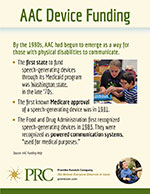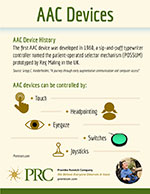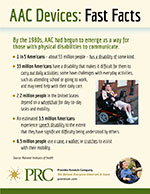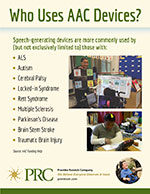October is Augmentative and alternative communication (AAC) Awareness Month!
Many people aren’t aware of, or don’t understand AAC. For those whom communication is difficult or impossible, AAC allows them to express their needs and wants, and more fully participate in decisions that affect their lives.
AAC also gives family members and others a way to more fully engage with an AAC communicator.
What is AAC
AAC is an umbrella term for communication methods. This includes anything someone may use to express themselves, from unaided communication that uses no equipment such as sign language, gestures and picture boards to aided communication that uses external tools such as mobile device apps and sophisticated, dedicated speech-generating devices (SGDs).
Whether someone is an aided or unaided communicator depends on his or her own unique set of circumstances. Thus, AAC can be used briefly (in the instance of someone who has suffered a stroke and is expected to eventually regain speech) or throughout the duration of their lifetime (those with cerebral palsy, autism, Rett Syndrome, traumatic brain injury, etc.).
What is an SGD?
SGDs produce electronic voice output. The communicator selects the letters, words, and messages, alone or in combination, to be spoken aloud in a pre-recorded or computer-generated voice (text-to-speech).
Again, depending on the communicator, if selecting keys via touch isn’t possible access to the device may be dependent on external aids including eye gaze, head pointing, joysticks, switches, or even a combination of these.
Timeline
A (very brief!) timeline on the history of augmentative and alternative communication.
| 16th Century | Manual alphabets and signs are widely used throughout Europe. In North American, Native Americans use a gestural system, Hand Talk, to facilitate communication between tribes. |
| 1920s: | The first widely available communication aid, a letter and word-based board, was developed by and for F. Hall Roe, who had cerebral palsy |
| 1950s: | Awareness of the needs of individuals with communication and other disabilities begins to grow, ushering in the modern era of AAC, with manual signs, communication boards and Morse code the primary methods used. |
| 1960: | In the U.K., Reg Maling creates a sip-and-puff typewriter controller named POSSUM (patient-operated selector mechanism), ushering in the era of electronic communication aids. |
| 1966: | Barry Romich and Ed Prentke meet and form Prentke Romich Company (PRC). |
| 1969: | PRC produces its first communication device, a typing system based on a discarded Teletype machine. |
| 1970: | Researchers at Delft University in the Netherlands create the LOT (lightspot operated typewriter), which uses head movement to point a small spot of light at a matrix of characters. |
| 1971: | Keyboard communication devices are developed in Denmark, the Netherlands and the U.S., increasing device portability. |
| 1980s: | Technology advances lead to more devices along with reducing size and price. Screen scanning becomes widely available. Eye gaze is introduced. Digitized and synthesized speech output becomes more common. |
| 1982: | Prentke Romich teams with Bruce Baker of SEMANTIC COMPACTION® to incorporate the MINSPEAK® vocabulary in PRC devices. |
Infographics
Download our infographics on AAC.
 |
 |
 |
 |
Learn more
- Wikipedia: Augmentative & Alternative Communication
- Wikipedia: Speech-generating Devices
- American Speech-Hearing Association
- New to AAC? Visit PRC's Caregiver Resource Center
- PRC: What is AAC?
Everyone has something to say. For those who cannot speak, AAC gives them their voice.
Blog















